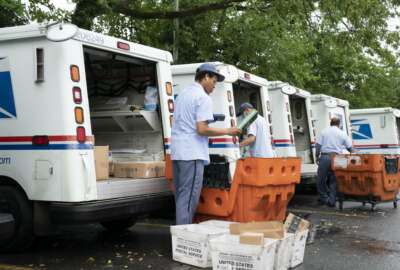Postal Inspection Service outlines steps to address ‘alarming’ rise in letter carrier robberies
The Postal Service and its law enforcement division are stepping up plans to address a rise in mail theft.
The Postal Service and its law enforcement division are stepping up plans to address a rise in mail theft.
USPS and its Postal Inspection Service are adding new security measures to its blue collection boxes to prevent criminals from stealing mail and altering checks. USPS expects these added security measures will also make letter carriers less of a target for criminals.
Postal Inspector Michael Martel told Federal News Network in a recent interview that USPIS has seen an “alarming” increase in letter carrier robberies in recent years.
Criminals are robbing letter carriers for their arrow keys, which are used to steal mail and packages, as well as commit financial crimes — including altering checks and committing check fraud.
“The core mission of the Postal Inspection Service is the sanctity and security of the U.S. mail, Postal Service employees and the customers themselves. We want the American people to have the utmost faith that if they’re dropping that bill payment into the mail stream, it will absolutely arrive to its destination. That’s one of our top priorities,” Martel said.
Ryan Moody, the senior vice president of payments product management at the marketing solutions firm Vericast, said fraud across nearly all methods of payment is on the rise — including checks.
“If you were to look broadly, fraud across payments is up,” Moody said. “Fraud is a topic [that’s] really everywhere, whether you’re talking about identity theft or things like that. Check fraud has not been left alone in that broader fraud trend.”
“Check consumers and check users skew older [and] certainly it skews typically higher income,” Moody added. “Those are things that are not great factors when you’re talking about the kind of the targets around this, from a fraud point of view.”
More than 400 on-duty letter carriers were robbed in fiscal 2022. USPS said in May that another 300 letter carriers were robbed on their routes so far in fiscal 2023.
USPS is also reporting an increase in thefts from blue collection boxes. The agency saw more than 38,500 incidents in FY 2022. Halfway through this fiscal year, USPS reported 25,000 blue collection box thefts.
The agency is planning to install 49,000 electronic locks on blue collection boxes in several cities, and will soon expand this effort to other cities. Martel said USPS and USPIS are also upgrading over 12,000 blue collection boxes with more advanced anti-theft features and security measures.
With these new security features, Martel said a letter carrier’s key alone won’t open the collection box, and will require a second level of authentication.
“What that does is it devalues the key. It devalues the very thing those criminals looking to rob our letter carriers are after in the first place.” Martel said “We’re looking to increase safety for our letter carriers by employing a technological approach to the issue and really devalue those keys that we’ve seen in the past.”
The Postal Inspection Service is also deploying its personnel nationwide to target hotspots of postal crime.
“We’re putting national assets where they need to be, from coast to coast, really to deal with postal crimes at a local level, putting national assets in areas to advance local cases, arrest criminals that are perpetuating postal crimes and putting them behind bars,” Martel said.
“We’re not going to fix this through arrests alone,” he added. “We take every opportunity to educate the American people about how to avoid becoming victims of postal-related crimes and crimes in general.”
USPS, amid this rise of letter carrier robbers, is keeping its postal police officers on USPS property.
The Postal Police Officers Association filed a federal lawsuit in March, calling on USPS to comply with a third-party arbitrator’s recent decision to throw out an August 2020 memo, which limited postal police to only carry out their duties on USPS property.
The memo has prohibited postal police officers from protecting mail and USPS employees, or carrying out other law-enforcement activity, anywhere other than on USPS property.
Moody said criminals are relying on “check-washing” schemes — using chemicals to erase all payment information from the check — to cash fraudulently obtained checks. However, he said checks filled out using a gel pen are harder for fraudsters to exploit, because the ink gets absorbed into the paper.
“When those chemicals get applied to a check that has that ink absorbed into the paper, those chemicals don’t stand much of a chance against that, so it’s very easy to see that check has been modified,” Moody said.
Martel said individuals can often prevent mail theft by not leaving mail uncollected in their mailbox for long periods of time, or opting to mail checks at a nearby post office.
“You can significantly reduce the chance of being victimized simply by removing mail from your mailbox every day,” he said.
Martel also urged individuals to track the status of incoming mail through Informed Delivery, a feature that sends USPS customers daily emails with scans of mail and packages they’re about to receive.
USPS is also seeing recent security measures curbing a spike in change-of-address fraud.
USPS recently implemented “dual authentication” identity verification for online change of address requests and has provided enhanced security controls to reduce fraud.
Starting May 31, post offices now offer an “enhanced” in-person change of address service, and require customers requesting the service to present a government ID.
USPS customers requesting a change of address will now receive a validation letter at their old address, and receive an activation letter at their new address.
“[It] almost is completely going to mitigate the issues that were appearing before, as far as change-of-address request fraud. It has been a very, very effective method to really stopping that,” Martel said.
The USPS inspector general’s office reported last month there were more than 23,000 cases of online change-of-address fraud and attempted identity theft in 2021 — a 167% increase compared to the previous year.
The USPS Office of Inspector General handles insider threats, or cases where USPS employees commit mail theft.
In one recent example, as reported by WTOP, federal prosecutors claim a former USPS employee in Washington, D.C. stole nearly $1.7 million in checks dating back to December 2021.
Copyright © 2024 Federal News Network. All rights reserved. This website is not intended for users located within the European Economic Area.
Jory Heckman is a reporter at Federal News Network covering U.S. Postal Service, IRS, big data and technology issues.
Follow @jheckmanWFED






